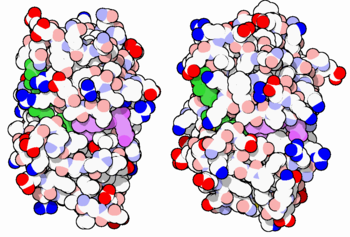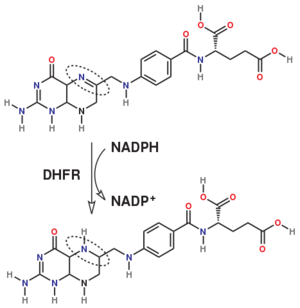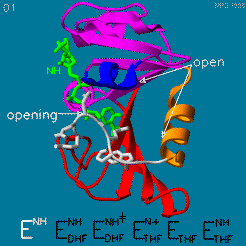Dihydrofolate reductase
From Proteopedia
| Line 1: | Line 1: | ||
| - | The enzyme [[dihydrofolate reductase]] (DHFR) occurs in all organisms and has been particularly well-studied in the bacterium Escherichia coli and in humans<ref>DOI:10.1146/annurev.biophys.33.110502.133613</ref>. It catalyzes the reduction of dihydrofolate to tetrahydrofolate, with NADPH acting as hydride donor. The human enzyme is a target for developing inhibitors used in anti-cancer chemotherapies, while the bacterial enzymes are targets for developing inhibitors as antibiotics. DHFR is a model enzyme for studying the kinetics, mechanism, and inhibition of enzymatic reactions and the underlying structure and conformational dynamics. | + | The enzyme [[dihydrofolate reductase]] (DHFR) occurs in all organisms and has been particularly well-studied in the bacterium Escherichia coli and in humans<ref>DOI:10.1146/annurev.biophys.33.110502.133613</ref><ref>https://en.wikipedia.org/wiki/Dihydrofolate_reductase</ref><ref>https://pdb101.rcsb.org/motm/34</ref>. It catalyzes the reduction of dihydrofolate to tetrahydrofolate, with NADPH acting as hydride donor. The human enzyme is a target for developing inhibitors used in anti-cancer chemotherapies, while the bacterial enzymes are targets for developing inhibitors as antibiotics. DHFR is a model enzyme for studying the kinetics, mechanism, and inhibition of enzymatic reactions and the underlying structure and conformational dynamics. |
| Line 49: | Line 49: | ||
=== Inhibitors === | === Inhibitors === | ||
| + | The human enzyme is sufficiently different from the bacterial enzymes to make specific inhibitors<ref>DOI:10.1038/s41429-019-0240-6</ref>. Inhibitors of the human enzyme are used in cancer treatment while inhibitors of the bacterials enzymes are used as broad-spectrum antibiotics or more specifically to treat | ||
Trimethoprim (TMP) is a known inhibitor of DHFR. | Trimethoprim (TMP) is a known inhibitor of DHFR. | ||
| + | |||
| + | Antifolate inhibitors like [[Methotrexate]] (MTX), which is very similar to folic acid, are used in cancer therapy. | ||
</StructureSection> | </StructureSection> | ||
| Line 60: | Line 63: | ||
| - | == Relevance == | ||
| - | |||
| - | Antifolate inhibitors like [[Methotrexate]] (MTX) which is very similar to folic acid are used in cancer therapy. | ||
== 3D Structures of Dihydrofolate reductase == | == 3D Structures of Dihydrofolate reductase == | ||
Revision as of 23:25, 6 January 2022
The enzyme dihydrofolate reductase (DHFR) occurs in all organisms and has been particularly well-studied in the bacterium Escherichia coli and in humans[1][2][3]. It catalyzes the reduction of dihydrofolate to tetrahydrofolate, with NADPH acting as hydride donor. The human enzyme is a target for developing inhibitors used in anti-cancer chemotherapies, while the bacterial enzymes are targets for developing inhibitors as antibiotics. DHFR is a model enzyme for studying the kinetics, mechanism, and inhibition of enzymatic reactions and the underlying structure and conformational dynamics.
Contents |
Sources
DHFR is found in all organisms. Some bacteria acquire resistance to DHFR inhibitors through expressing a second form of DHFR coded on a plasmid. The enzymes from E. coli and humans have similar folds, while the plasmid-encoded enzyme has an unrelated fold. In humans, DHFR is expressed in most tissues[1], and there are two genes, DHFR and DHFR2/DHFRL1, the latter targeted to mitochondria[4]. Mice and rats lack the second gene but also show DHFR activity in mitochondria[5].
Reactions catalyzed
Dihydrofolate reductase (DHFR, 1.5.1.3 [2]) is an enzyme which uses the co-factor NADPH as electron donor which converts it to NADP. It catalyzes the reduction of dihydrofolic acid (DHF) to tetrahydrofolic acid (THF). The mammalian enzymes also accept folic acid as a substrate, reducing it to THF. This allows the use of folic acid, which is easier to synthesize than DHF or THF, to fortify food.[6]. Some bacterial enzymes also accept folic acid as a substrate [7] but it acts as a competitive inhibitor in the E. coli enzyme.
The folate is a form of the essential vitamin B9. Folate is not part of our natural diet (it contains dihydrofolate and tetrahydrofolate, sometimes as a poly-glutamate conjugate) but is bioavailable and simpler to synthesize.
Relevance
DHFR forms a complex with thymidylate synthase (TS)[8]. Both enzymes participate in the biosynthesis of pyrimidine.[9]
| |||||||||||
See also
3D Structures of Dihydrofolate reductase
Dihydrofolate reductase 3D structures
Additional Resources
- For additional information, see: Cancer.
- See also Molecular Playground/DHFR.
References
Proteopedia Page Contributors and Editors (what is this?)
Michal Harel, Karsten Theis, Alexander Berchansky, Joel L. Sussman, Tzvia Selzer, Jaime Prilusky, Eric Martz, Eran Hodis, David Canner



